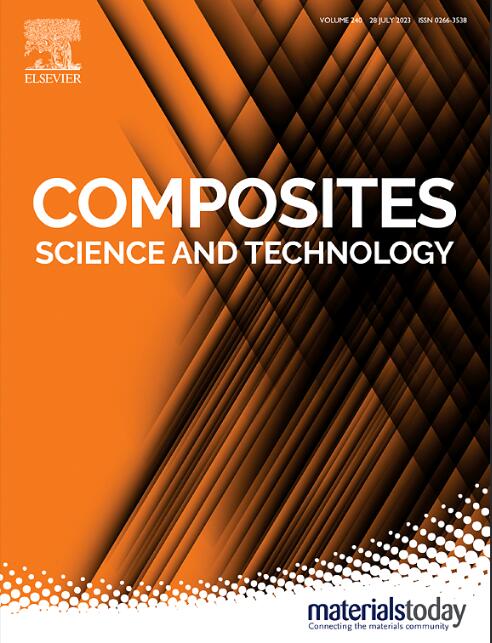单宁酸/聚乙二醇/Fe3+形成的三作用协同界面改善了短竹纤维/PBSA生物复合材料的性能
IF 8.3
1区 材料科学
Q1 MATERIALS SCIENCE, COMPOSITES
引用次数: 0
摘要
竹纤维增强聚合物复合材料由于界面相容性差,在提高复合材料性能方面面临很大挑战。本研究基于单宁酸(TA)、Fe3+和聚乙二醇(PEG)之间的配位和分子交联反应。通过简单的一锅水反应和热压工艺,在BFs/PBSA复合材料中获得了刚柔平衡、分子交联和机械互锁的三作用机制界面。该界面显著提高了复合材料的性能。其中,复合材料的拉伸强度、拉伸模量、弯曲强度、弯曲模量和冲击强度分别提高了20%、13%、38%、14%和54%,最大储能模量提高了71%。初始和最大降解温度分别提高了17.1°C和19.2°C,吸水率降低了34%。这些结果表明,该界面在制备高性能植物纤维增强聚合物复合材料方面具有广阔的潜力。本文章由计算机程序翻译,如有差异,请以英文原文为准。

A triple action mechanism synergistic interface based on tannic acid/poly (ethylene glycol)/Fe3+ formation for improving the properties of short bamboo fiber/PBSA biocomposites
Bamboo fibers (BFs) reinforced polymer composites face significant challenges in enhancing composite properties due to poor interfacial compatibility. This study is based on the coordination and molecular cross-linking reactions between tannic acid (TA), Fe3+, and polyethylene glycol (PEG). A triple-action mechanism interface integrating rigid-flexible balanced, molecular cross-linking and mechanical interlocking was obtained in BFs/PBSA composites by a simple one-pot water reaction and hot pressing process. The interface significantly improved the performance of the composites. Specifically, the tensile strength, tensile modulus, flexural strength, flexural modulus, and impact strength of the composites were increased by 20 %, 13 %, 38 %, 14 %, and 54 %, respectively, while the maximum energy storage modulus was enhanced by 71 %. Additionally, the initial and maximum degradation temperatures increased by 17.1 °C and 19.2 °C, respectively, and water absorption decreased by 34 %. These results demonstrate the promising potential of the interface for preparing high-performance plant fiber-reinforced polymer composites.
求助全文
通过发布文献求助,成功后即可免费获取论文全文。
去求助
来源期刊

Composites Science and Technology
工程技术-材料科学:复合
CiteScore
16.20
自引率
9.90%
发文量
611
审稿时长
33 days
期刊介绍:
Composites Science and Technology publishes refereed original articles on the fundamental and applied science of engineering composites. The focus of this journal is on polymeric matrix composites with reinforcements/fillers ranging from nano- to macro-scale. CSTE encourages manuscripts reporting unique, innovative contributions to the physics, chemistry, materials science and applied mechanics aspects of advanced composites.
Besides traditional fiber reinforced composites, novel composites with significant potential for engineering applications are encouraged.
 求助内容:
求助内容: 应助结果提醒方式:
应助结果提醒方式:


